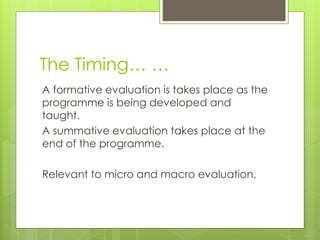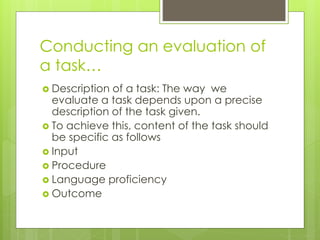Material adoptation
- 2. Dimension of the Evaluation Approach: Objective model and responsive evaluation are two major approaches. The objective model belongs to the psychological tradition of educational research. Here, the achievement can be determined and the learners capacity and learning outcomes can be measured.
- 3. Responsive Evaluation… It belongs more to the sociological tradition of educational research and its ideographic in approach. Its aim to illuminate the complex nature of the teaching learning process.
- 4. Purpose… Two major purposes... …accountability and development. The purpose of the development is to determine whether the destined destinations of the program have been met. The purpose of the development may be either to improve the curriculum or to foster teacher teacher-development or both.
- 5. Focus… … Effectiveness and Efficacy. The programme is effective or not for the needs of the learners. Does the programme fulfill the needs of the learners more effectively than some other alternative program? The evaluator needs to compare with what the learners knew and were able to do before starting the program and with what they know and able to do at the conclusion of the program.
- 6. Scope… The scope of the evaluation can be internal or external. It uncritically accept the goals of the program . It submits the goals of the programme properly.
- 7. Evaluators… It is a matter of consideration that who is the evaluators of the programme. It should be restricted from the outside so that both inside and outside evaluators can evaluate the programme properly.
- 8. The Timing… … A formative evaluation is takes place as the programme is being developed and taught. A summative evaluation takes place at the end of the programme. Relevant to micro and macro evaluation.
- 9. Types of Information…. An evaluation based on objectives model Approach traditionally relies on one type of information: a)learners’ test scores. A responsive evaluation will require a greater variety of information including a)Documentary information b)Information collected by means of self- report c)Information collected from classroom observation.
- 10. Conducting an evaluation of a task… Description of a task: The way we evaluate a task depends upon a precise description of the task given. To achieve this, content of the task should be specific as follows Input Procedure Language proficiency Outcome
- 11. Planning the evaluation… It demands the prior consideration because without prior planning it may prove impossible to achieve a systematic and principled evaluation.
- 12. Collecting information A task evaluation will need to consider three types of information. 1.information about how the task was performed 2.Information about what learning took place 3.Teacher’s and learner’s opinion about the work.
- 13. Analysis of the information collected…. Qualitative analysis and quantitative analysis. While the former involves the use of umber to determine rating numerically, the later is a more holistic and impressionistic which evaluate tasks in the light of representative responses.
- 14. Conclusions and recommendations… … What has been discovered as a result of analysis. Recommendations concern proposals for future teaching
- 15. “Teachers’ needs and wants from course books” Needs analysis has featured prominently in the literature of language teaching in the last 20 years but most of what has been written has focused on learner’s communicative needs. Teachers’ needs are treated as a part of situation analysis. In literature, needs are defined in 3 terms. They are: a) ownership b) kinds c) sources.
- 16. When teachers are asked what their needs from a course book 1. Teachers’ perception of administrative needs. e.g. The school is under-resourced and a very strict syllabus is set which the teachers’ are expected to obey. 2. measured learners’ needs’: e.g. The teacher has administered a diagnostic test at the beginning of the course and is aware of the learners’ communicative needs.
- 17. 3. Teachers’ perception of learners needs: The teacher believes that Japanese students are quiet shy and thus require special training in speaking. 4. Teachers’ wants: Even though ELT experts recommend a learner-centered approach these days and the other colleagues of the language centre follow the trend, the teacher prefers and also secretly believes in the value of a teacher-centred approach for certain learners.
- 18. Teachers’ needs would consist of two general areas: one deriving from personal traits such as their age, sex, cultural and educational background the other from their professional traits such as areas and levels of expertise, length and types of teaching experience.
- 19. a) Self-perceived needs – the needs which are reported y the teacher. These are what teachers themselves can articulate. b) Needs perceived by others – the needs of the teachers which they are not aware of and thus cannot articulate themselves and which are identified by others (e.g. colleagues, teacher- trainers, researchers) in response to qualitative data(e.g. observation of the teachers’ teaching, analyzing the tendency in interview and questionnaire responses of the teacher).
- 20. c) Objectively measured needs – the needs which are identified in objective studies in which quantified data is collected , analysed and interpreted by a third party who tries to be detached, unbiased and accurate.
- 21. Teachers’ wants: In many cases, what may be identified by the teachers themselves and by a third party as their ‘needs’ could be their ‘wants’ as well.
- 22. The study of teachers’ wants may reveal that teachers’ commitment and involvement due to their preference for materials and methods are keys to effective language learning.
- 23. Teachers - an endangered species Exploring teachers’ needs and wants is crucial when the role division between the materials producers (e.g. professional materials writers and publishers) and the users (e.g. teachers, educational administrators and learners) seems to be becoming more and more evident. Remarkable technical advancement has brought sophistication and a great proliferation of ESL/EFL coursebooks but it has also created a wider role division between materials producers and materials users.
- 24. The division between the producers and users has also affected the coherent linear sequence of curriculum development/course design processes to the level that concerns are being expressed that the materials could carry the threat of deskilling teachers by reducing the teachers’ role.
- 25. Various different models of the process of course design (e.g. Johnson 1989; Dubin and Olshtain 1986; Richards 1990) Firstly, the teachers and administrators draw up a very general framework of a particular class and learners. In this framework, the characteristics of the learners are defined in terms of the learners’ preference for a course and the levels of their proficiency based on the tests administered at the beginning of the course. The goal of teaching is usually represented in the name of the course.
- 26. Materials selection holds an assertive position in the second stage in the sequence; the teachers and administrators select from commercially available coursebooks the one suitable for the class defined in the initial stage. In fact producers provide prospective selectors (e.g. administrators and teachers) with information as to the target learners, objectives and methodology in the blurbs or in the introductions of the books. They may also provide a syllabus map indicating ho units are integrated into a coherent course.
- 27. The materials writer and the publisher who produced the materials have more direct control of the course design processes than the teachers. The degree of dominance depends on how closely the teachers choose to follow the coursebook or hoe much teachers take initiative in making flexible use of the materials.
- 28. Empowerment of teachers Four areas are recognized in which teachers needs and wants could be reflected in the development and use of materials. Quality assessment of published course books: a) The needs for objective measurement of the quality of published course book. According to Seldon several ways of realizing these including: ˃ Desirability and introducing a Which? Magazine for ELT course books. ˃ Improvement and innovation in ELTJ reviews in order to enhance their validity, usefulness and availability.
- 29. b) Stricter and more systematic materials selection procedures. Many checklists are now available which are designed to enable systematic selection of materials. It would be useful to have a survey review comparing these checklists. C) Establishing methods and feedback routes of user’s evaluation. Three kinds of evaluation according to Rea- Dickins are: ˃ Pre - use evaluation which can be done prior to use of a course book. ˃ in - use evaluation ˃ Post use evaluation, measured in terms of learners performance.
- 30. d) Establishing system for teachers need and wants to be reflected in the production process. e) Wider perspectives in teacher development. It includes teaching development components of materials evaluation, adaption and writing. It also includes of researches methodology training in post graduate courses in TEFL/TESL and applied linguistics. Besides, institutions could make more use of staff meetings to provide opportunities for teacher’s development.
- 31. Developmentstages Decisionmaking roles Products 1.Curriculum planning Policy maker Policy documents 2.Specification: Needs analysts Ends Methodologists Syllabus Means 3.Programme implementation Materials writer Teaching materials Teachers trainers Teachers training programme 4.Classroom Implementation Teacher Teaching acts Learner Learning acts
- 32. Opportunities for Change… Tomlinson stresses that evaluators need to develop their own principled criteria which take into consideration the context of the evaluation and their own beliefs. He claims that evaluation criteria should be developed before materials are produced, and used to make decisions about the approach, procedures and activities to be adopted as well as to monitor their development and subsequent use.
- 33. Tomlinson differentiates between universal and local criteria, the former being those that can be used to evaluate materials for any learner anywhere. To generate these criteria he advises evaluators to brainstorm a list of principled beliefs that they hold about how languages are most effectively acquired and then convert these beliefs into criteria for evaluating materials, such as ‘Are the materials likely to achieve affective engagement?’
- 34. Tomlinson recognizes that evaluation is inevitably subjective, that it ‘focuses on the users of the materials’ and attempts to measure the potential or actual effects of the materials on their users. In contrast, analysis focuses on the materials and aims to identify what they contain, what they ask learners to do and what they say they are trying to achieve, aiming to provide an objective account of the materials, though the selection of questions is inevitably subjective and there is often a hidden agenda which it is hoped the revealed data will support.
- 35. we need textbooks to save time and money and many teachers want a coursebook which provides everything they need in one source.


































